The Long Road to Capadoccia
Sleep didn't help. Food definitely didn't help. We were still pathetic but upright. It was going to be a long ride to Capadoccia but sitting on a bus beat walking around sightseeing -- that shows you how beat up we were. We had a stop in Ankara - the capital of Turkey to view Ataturk's (founder of Turkish democracy) tomb. It was an impressive tomb with an interesting (we're told) museum. We wandered listlessly. At the next stop, the Anatolian museum, we just stayed on the bus and dozed. This is not a terribly interesting entry but any of you who have been sick while traveling and in a situation beyond your control will know exactly how we felt.
 |
| Mustafa Kemal Atatürk, was the founder and first President of the Republic of Turkey from 1923 to 1938. This is his tomb in Ankara. |
 |
| We happened to be there for the changing of the guard at the tomb. |
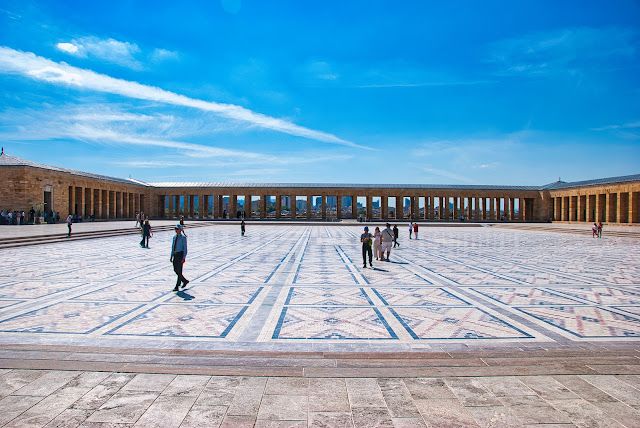 |
| Looking away from the building of Ataturk's tomb to the massive courtyard in front of the tomb. |
Somewhat rejuvenated we partook of a visit to a Hittite city that thrived somewhere between 1700 and1200 BC. This was truly fascinating and our first experience with the manner in which early inhabitants carved houses, stables and elaborate temples or churches into the mountains. This approach made so much more sense than constructing in wood or earthen structures. The weather there is extreme -- very cold in winter and hot in summer and these cave-type shelters provided insulation and a much more defensible community. The size of the village was impressive as were the stones that were huge with a green veneer that were hauled significant distances to be used in construction. Artisans were selling small examples of the carving techniques employed by those thousands of years ago.
 |
| A very large green stone used in the construction of the city of Hattuša, the capital of the Hittite kingdom in the 13th century BC. |
 |
| This lion carved out of stone marked the entrance to the Lion's Gate of the city. |
 |
| The lion on the right has suffered more from the ravages of time than the lion on the left. |
 |
| There was another narrow passage through the rock... |
 |
| which marked another, less accessible but more defensible entrance to the city. |
 |
| This was known as the Sphinx's gate. |
 |
| Looking down on the ruins of the Hittite city, which had great influence over Anatolia in present day Turkey and ancient northern Syria. |
 |
| The YaziliKaya (written rock) is the largest known outdoor temple and rock sanctuary. |
 |
| The complex was given its present form as a memorial chapel for Tudhaliya IV, Great King of Hattuša by his son Šupiluliuma at the end of the 13th century BC. |
 |
| The burial chamber for the King. |
We finally pulled into Capadoccia and hoteled up. At dinner our guide looked at us, took pity on us and took Michael to a pharmacy to see what wonders they could work on us. This is why we have a rule of using guides when we can't understand the language or even the alphabet. Actually Turkey does use the Roman alphabet but the language is tough. I digress.
 |
| Before getting to our hotel, we visited this area of a rock cut Church and monastery. |
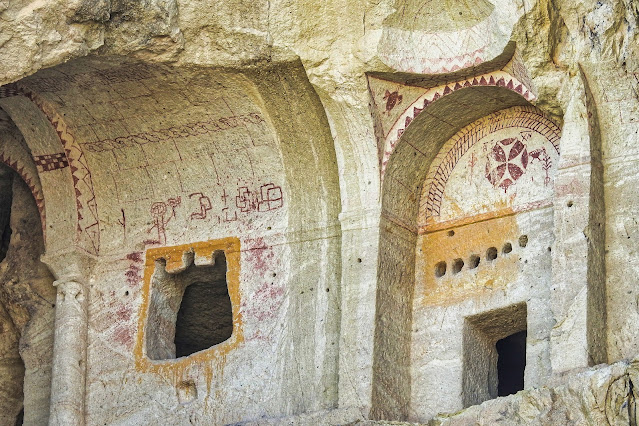 |
| Christianity arrived in Capadoccia in the 1st century AD. |
 |
| We also visited the largest rug dealer and producer of rugs and carpets in Capadoccia. The woman is following the pattern above to weave the carpet by hand. |
 |
| This shows the difference between the Turkish knot and the Persian knot. The owner explained that because of this difference the Turkish carpets do not unravel, if when you have a cat who uses the carpet as its scratching pad. |
 |
| After each row of knots is tied & shears are used to cut the threads. |
 |
| We were also given a demonstration of making silk thread from the cocoon's of the silkworm. Each cocoon can produce a single, continuous thread from 1 to 1.6 kilometers long and each thread is only 1/2500th of an inch in diameter. |
 |
| We were shown many rugs of wool and the one above of silk, which we were encouraged to feel with our bare feet. |
 |
| The size of some of these rugs was quite impressive given the amount of time required to produce them by hand. The knots per square inch for a quality carpet can vary from 100 to 2,000 knots for the very finest of rugs. |
 |
| Many rugs were laid out to tempt us to buy, but we managed to resist the urge. |
 |
| There were even paintings created from hand knotted silk. |
Come and Take a Ride in My Beautiful Balloon
Medicated, the world looked like a better place in the morning. Many of our tour pals opted for hot air balloon rides but we passed. These balloons are really big - like 25 or 30 people in each basket. They divide the baskets into compartments to balance the load. Capadocia is a premier venue for hot air ballooning and it is truly stunning to see tens, if not hundreds of balloons serenely drifting above the very dramatic landscape. There are now over 100 balloon companies operating in Capadoccia.
 |
| This was just one of the many balloons in the air at any given time. On a good day, like the one our tour had, there were over 100 balloons in the air. |
About the Landscape
In large measure people venture to this area to see the unique rock formations unlike anything seen like this anywhere else in the world. I think the closest would be the hoodoos at Bryce National Park in the United States. Like those, all these formations were created by erosion and water entering cracks, freezing, expanding and cracking the rocks into unusual forms. We went to Rose Valley, Apple Valley and Pigeon Valley to view and compare them. To me the fairy caps were the most interesting. Take a look and see what you think.
 |
| Due to the erosion of the rocks they can take on various forms. I called this one the rabbit. |
 |
| This one was the lady with the thin neck. |
 |
| The rock formations allowed your imagination to run wild. |
 |
| These are called fairy caps, which due to the difference in the type of stone lead to these "caps". |
 |
| Some are very precariously balanced and some have been known to fall as the elements erode their base. |
 |
| Because of the soft stone early man carved out rooms with windows. |
Oh, That's too Creepy for MeI haven't cited any of my well known phobias lately but this sight triggered SO many. Yes, it was the Underground City. Claustrophobia, the fear of depths, possible snakes, --well you get the picture. So I wandered above ground while my fearless spouse descended. Our guide said that this particular underground dwelling was rather tame. It only descended two stories. He had been in one that was seven stories deep in which you had to crawl through narrow slits to move from room to room. Nightmare stuff. But the worse was their defensive maneuver where they would slide a hug stone over the entrance to repel enemies. Locked underground by a rock! I can't even think about it.
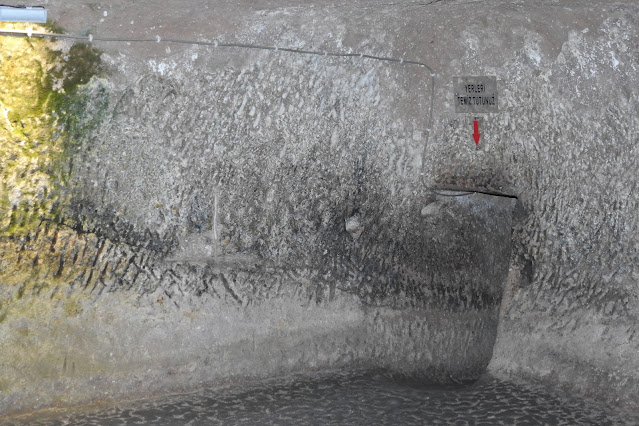 |
| The rooms and the tunnels connecting them were well lit for the most part. |
 |
| Above you can see the round stone rolled over the entrance to keep out raiders and invaders. |
 |
| There was a shaft cut through the rock to let in light and let out smoke. |
 |
| Looking down on Avanos you can see a number of dwellings are cut into the rock. |
 |
| The rocks have provided homes and shelter for countless generations throughout the millennia. |
 |
| You could even take a camel ride. |
 |
| Looking at this I realized this must have been the first high rise apartment buildings in the world. |
 |
| This tree was festooned with amulets to protect against the "evil eye". |
 |
| We also visited a ceramics factory which made some amazing hand decorated pottery. |
 |
| Some of the designs were so intricate and detailed, it is hard to believe anyone could hand paint something like this. |
 |
| There were many of these on display in different sizes with different hand painting. This is a reproduction of an ancient Hittite wine jug. The server could put there arm through the hole and rest the jug on their shoulder and tilt the jug forward to fill a cup with wine. |
Whirling, Whirling
One of the absolutely neatest parts of this trip was seeing Whirling Dervishes. Founded by the poet Rumi whirling is actually a form of meditation. One night we went to a caravanserai where the whirling dervishes would do their thing. We had been to one caravanserai earlier in the trip. We were on the Silk Road and these building were constructed at a distance that a camel could walk in a day. So, there were a lot of them. It would take a trader leaving China about one year to travel the Silk Road to Smyrna (now Izmir) where their goods would be loaded onto ships to move on to other ports in Europe. These outposts were full service: saddleries, medical people, supply stores and sleeping quarter. The ones we saw were very attractive. In any case, the dervishes performed their meditative practices in one of these facilities. Michael's pictures will help tell the tale.
 |
| This was the entrance to the caravanserai where we went to see the Whirling Dervishes. |
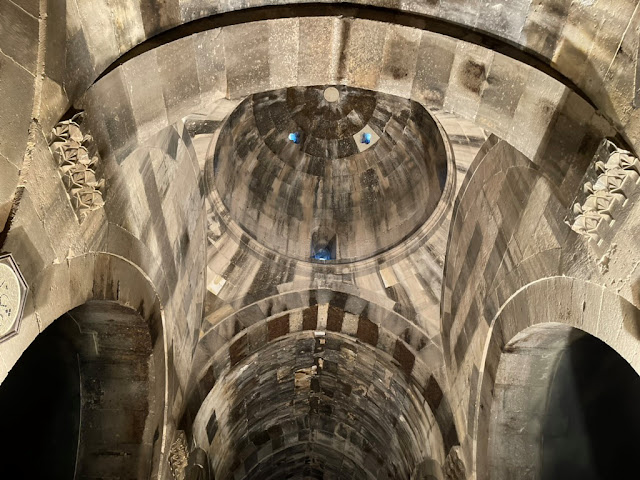 |
| The interior of the caravanserai was very impressive. Later in the blog I explain in greater detail the significance of the caravanserai. |
 |
| The Sheik Efendi remains clothed in the tennure, which represents the shroud of the ego. The cap or sikke, shaped like a tombstone, represents the tombstone of the ego. The musicians in the background provide music throughout the ceremony. |
 |
| The dervishes drop their tennures and are clothed in their waistcoats, which represent the ego itself. |
 |
| The ceremony begins with crossed arms on chests representing God's uniqueness. |
 |
| One at a time each dervish enters the semahane and begins the sema... |
 |
| until all are twirling with one hand pointed toward heaven and one hand pointed down to the earth, twirling in meditation with eyes closed, The Sheik Efendi is walking among the whirling dervishes with eyes closed, but never does he bump into or is he touched by the hands of the whirling dervishes. |
More on Rumi and the Dervishes
Our next stop was Konya where we visited the Rumi museum. When Ataturk ran the show he believed in a secular society. He ordered that Rumi's monastery be turned into a museum. It is beautifully preserved and provides a clear insight into the beliefs and practices of the group. To learn to be a dervish one had to first sit outside the gate for three days without eating, drinking or sleeping. Assuming you made it through that you would then enter the program which featured 1,001 days of meditation and introspection. I'm not sure what kind of actual instruction took place but whirling was definitely part of it. Aside: When we returned to Ajijic and was describing the whirling of the dervishes to a friend he causally said: "Oh, I know how to whirl." It turned out he had learned how to do it in Canada from a follower of Rumi. I love living here.
 |
| Before reaching Rumi's tomb and the Mevlevi museum, we saw the largest caravanserai ever constructed, consisting of 4866 square meters and built in 1229. It is the Sultan Seljuk caravanserai. The entrance alone was most impressive. |
 |
| The caravanserai contained workshops for saddlers, rope makers, horseshoers, iron smiths, a small mosque (Masjid), kitchens, sleeping rooms, hammams (bathing rooms), medical clinics, tea & coffee houses and separate quarters for riding and load carrying animals. These provided accommodation, food and drink for free for up to three days for both local people and travelers. |
 |
| These women are working on a reproduction of a 14th century Selçuk period royal court carpet. |
 |
| The caravanserai had this display of infinity mirrors... |
 |
| as well as photos of scenes of Turkey. |
 |
| The Mevlevi Museum containing the tomb of Rumi Mevlevi and other items from his life. |
 |
| The Tilavat chamber is where the dervishes read the Koran while Mevlevi lodge was functioning. Atatürk secularized Turkey and it was then this became a museum. |
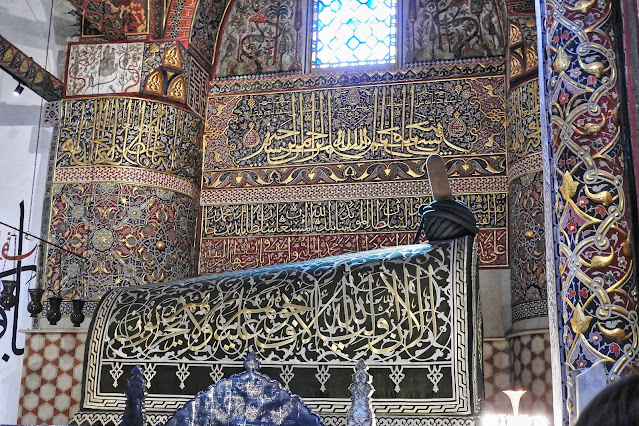 |
| Rumi's tomb. |
 |
| Constucted on order of Sultan Selim II in the 16th century. This dome covered the semahane, a square like structure 12.5 meters in diameter known as the "Meydan-i Sharif" (Holy Square), where the sema was performed. |
 |
| Rumi's cloak from the 13th century. |
 |
| The 18 branched candlestick used in the sema ceremony. |
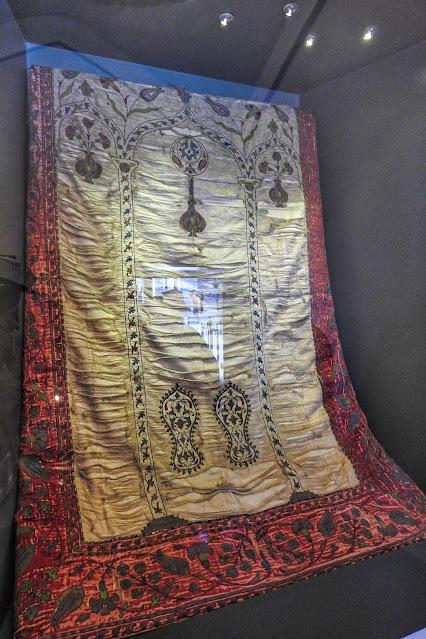 |
| This was a 16th century Ottoman prayer rug on display in the museum. |
Well, by this time we were actually feeling like real human beings again. It was time to head towards the coast. We would traverse the Taurus mountains--a wild and beautiful area where wolves still roam and the vestiges of thousands of years of civilization are tucked away.






























































Interesting as Always. Glad you started feeling better so you could enjoy all that. What tour company did you use?
ReplyDeleteWOW it should have been an incredible experience. I would like to visit Turkey.
ReplyDeleteYour wonderful pictures and very interesting comments about the places are so inspiring.